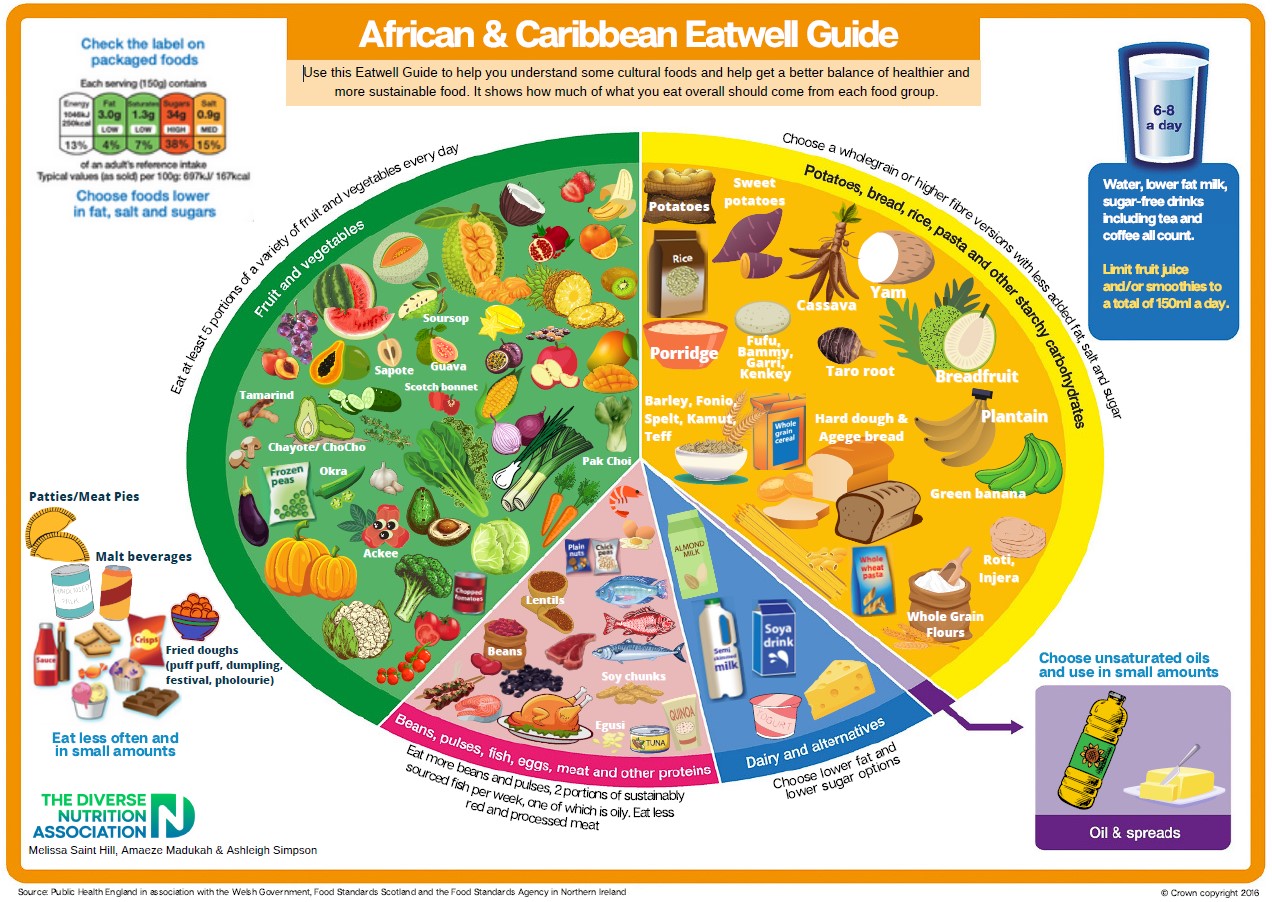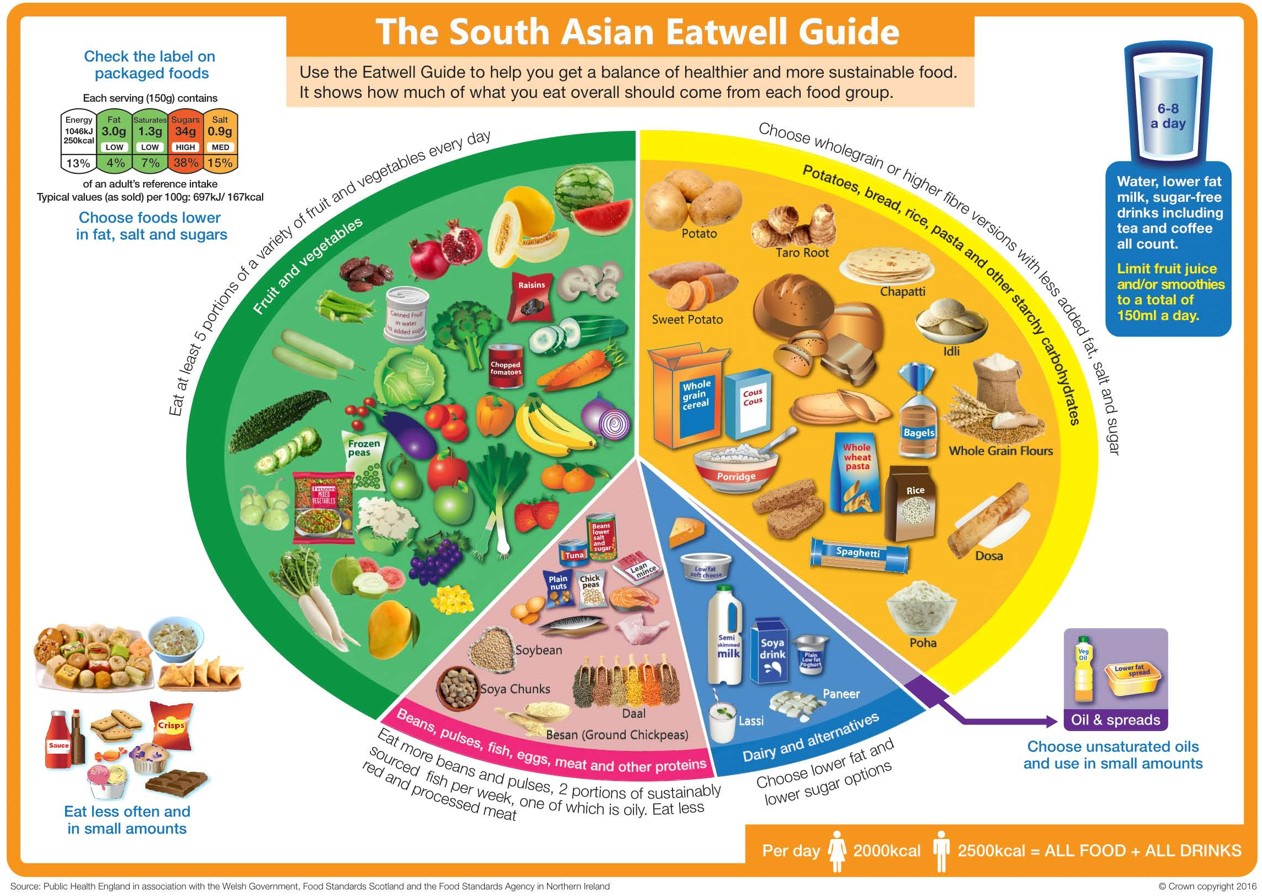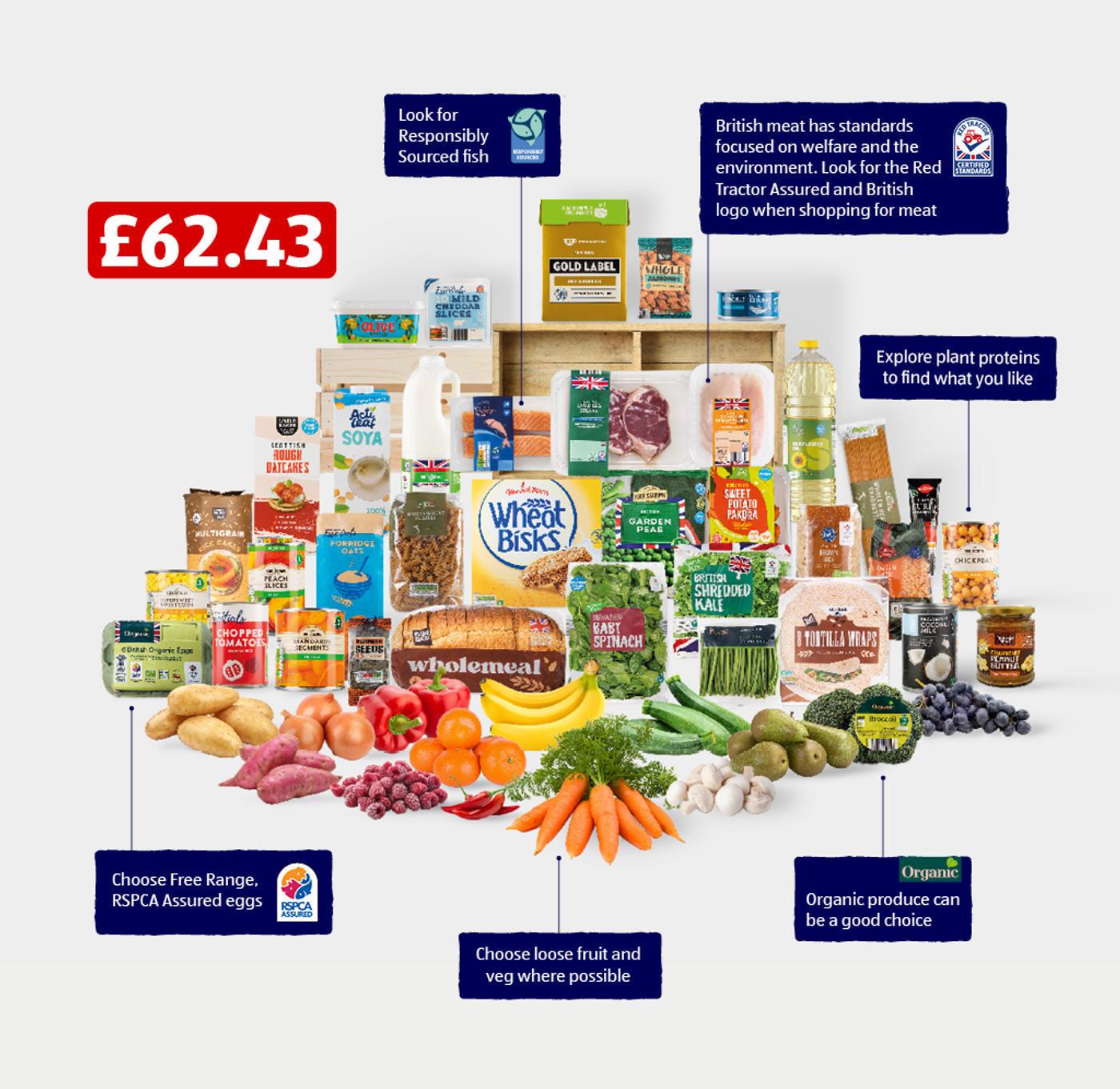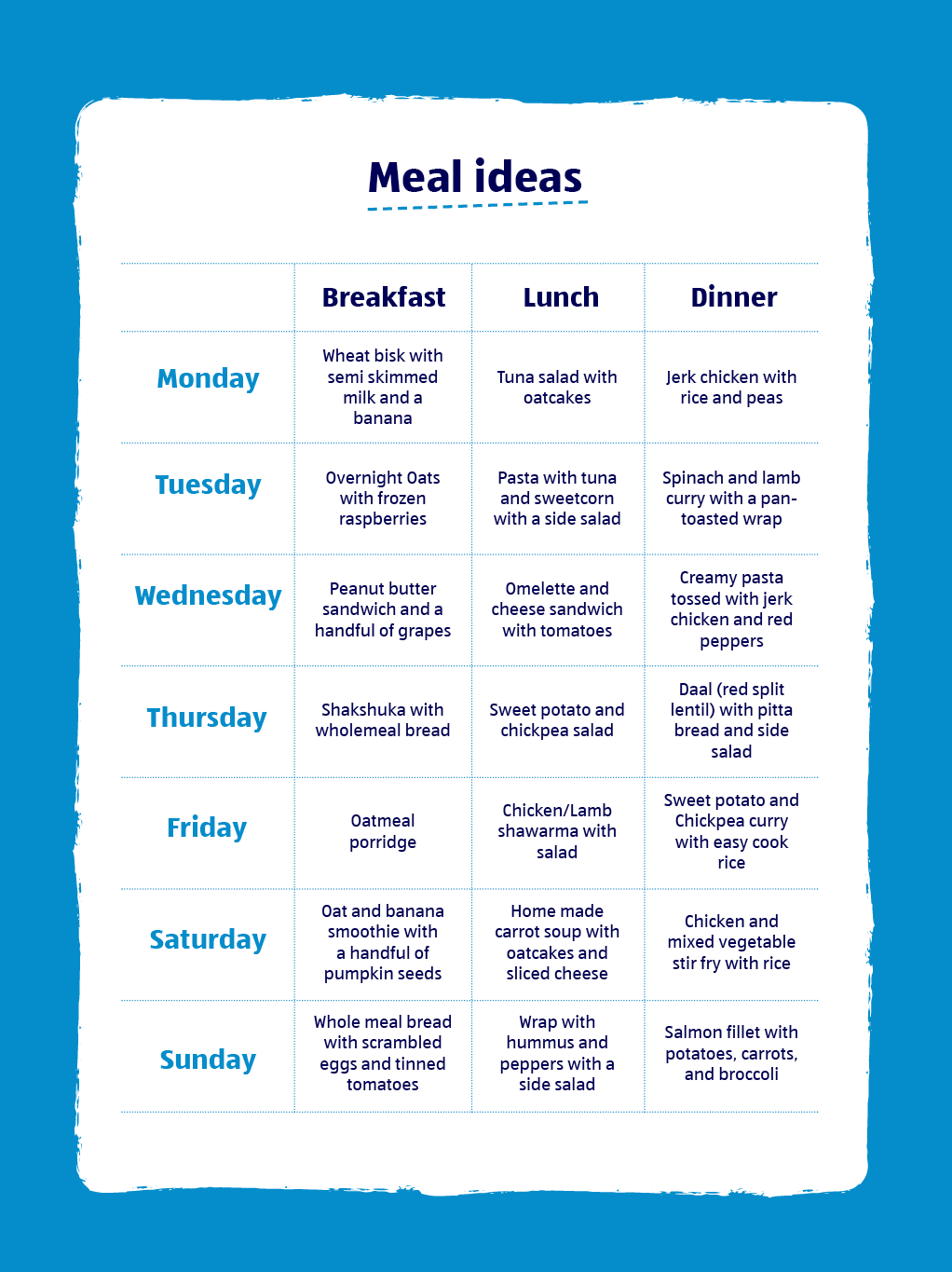Introduction
Landmark reports on sustainable diets
There have been many UK reports and research projects describing diets that are healthy (providing sufficient, but not excess, energy and nutrients), and that also consider diverse aspects of food production, processing and distribution in relation to environmental limits. Listed below are those that provide quantitative and/or qualitative advice on consumer food choices that align human and planetary health.
British Dietetic Association report One Blue Dot (BDA, 2018)
The BDA is the professional association for dietitians in the UK, and currently has 11,500 members. Most dietitians work within the National Health Service or in private practice providing guidance for all aspects of medical care requiring dietary modification and treatment. Dietitians also work in industry, education and media settings, giving expert science-based advice to support food policy decisions.
In November 2018 the BDA issued the report: Eating patterns for health and environmental sustainability. The wider project was named One Blue Dot® (a reference to the phrase, ‘Pale Blue Dot’ by astronomer Carl Sagan, describing a picture of plant Earth taken by a space probe).
A BDA expert group reviewed scientific literature on nutrient intakes and patterns of UK diets and examined also, the environmental effects from the production of foods. The report considered the nutritional consequences of population-wide protein transition (= reductions of animal protein foods and increases in plant protein foods) and issued guidance on the communication of environmentally sustainable diets to the UK public.
The BDA environmentally sustainable diet recommendations for the UK population
|
Red meat |
Avoid processed meats. Reduce intakes of red meat: 500g weekly maximum |
|
Plant proteins |
Increase |
|
Fish |
From sustainable sources |
|
Dairy |
Moderate intakes |
|
Starchy foods |
Recommend mostly wholegrain |
|
Fruits and vegetables |
Increase intakes, especially seasonal and locally produced product, and tinned/ frozen. Reduce air freighted and pre-packed salad items |
|
Portion control |
Avoid high Fat, Sugar and Salt (HFSS) foods. Reduce animal proteins and moderate dairy proteins |
|
Hydration |
Choose tap water and tea or coffee over soft drinks |
|
Reduce food waste |
Reduce, especially perishable fruit and vegetables. Recycle food waste |
Reductions in animal proteins generally, and with meats specifically, will result in reduced dietary intakes of some micronutrients. Dietitians advising on low meat or vegetarian diets, consider intakes of iron, zinc, calcium, iodine and vitamin B12. Avoidance of fish may reduce intakes of iodine and the benefits of long chain omega 3 fatty acids. In many cases, fortified foods and/or the use of supplements would be recommended to ensure adequate intakes of particular micronutrients.
EAT-Lancet Commission report Food in the Anthropocene: healthy diets from sustainable food systems (Lancet, 2019)
The EAT-Lancet commission is made up of 37 experts from 16 countries. The commission secretariat is based in Stockholm, and is funded by the Wellcome Trust, the Stordalen Foundation and the EAT Foundation. Although the inputs and perspectives for this report are international, the project is hosted by the UK medical publication The Lancet.
The commission reviewed healthy diets, defined to reduce premature deaths from chronic disease, and food production that affected planetary boundaries assessed by six measures: greenhouse gas emissions, cropland and water use, nitrogen and phosphorus application, and biodiversity scores.
The commission calculated a global healthy reference diet to achieve adequate and balanced macro- and micro-nutrient intakes (calculated from US nutritional recommendations) for an intake of 2500 kcals/day. These reference figures need adjustments for the nutritional status of different global populations, and to allow for cultural and economic variations in relation to food consumption. For example, red meat consumption in Sub-Saharan and South Asian diets is below the EAT-Lancet dietary reference; global average diets exceed red meat reference levels by nearly three-fold; North American diets exceed levels by over six-fold.
EAT-Lancet healthy reference diet for 2500 kcal/day
|
|
Food intakes g/day |
Energy intakes, kcal/day |
|
Grains, preferably wholegrain |
232 |
811 |
|
Plant protein foods |
97 |
615 |
|
Vegetables |
300 |
78 |
|
Fruits |
200 |
126 |
|
Added fats |
52 |
450 |
|
Dairy – milk or equivalent |
250 |
153 |
|
Animal protein foods |
56 |
111 |
|
Tubers |
50 |
39 |
|
Sugars |
31 |
120 |
Compared to the EAT-Lancet diet, current typical UK diets contain less fruits and vegetables, less fish, and less legumes, but more starchy tubers, more meat and dairy foods, and more sugars.
Compared to the EAT-Lancet diet, typical UK diets contain less fruits and vegetables, less fish, and less legumes, but more starchy tubers, more animal proteins (meat and dairy), and more sugars.
EAT-Lancet dietary consumer messages
- Embrace plants as a source of protein. Aim to consume at least 125g of dry beans, lentils, peas and other nuts or legumes per day
- Go easy on meat consumption. Excess meat can harm health and the planet. Aim to consume no more than 98g of red meat (pork, beef or lamb), 203g of poultry and 196g of fish per week
- Approach food in moderation. Consuming too much food can lead to weight gain and other problems.
- Cook more at home. Preparing food at home provides opportunities for shared family time
- Waste not, want not. Consider food waste
UK Committee on Climate Change report Net Zero (CCC, 2020)
The UK agreed binding legislation on government policy to achieve net zero greenhouse gas emissions by 2050. The CCC report directly to Parliament on progress made in reducing greenhouse gas emissions. Their report Net Zero – The UK’s contribution to stopping global warming includes specific recommendations that UK dietary intakes of ruminant meat (mainly beef and lamb), and dairy should be reduced by 20%. The general message to the consumer is, “Eat less beef, lamb and dairy.”
National Food Strategy (Dimbleby) report (DEFRA, 2021)
DEFRA commissioned Henry Dimbleby to write the National Food Strategy for the UK. His report was published in 2021 and considered diets that would be both healthy and affordable, and would support a resilient, environmentally sustainable and humane agricultural sector. The report provided great depth and detail on the many complex factors affecting UK food purchase and consumption and recommended four changes needed by 2032 (compared to 2019) to meet health, climate, and nature commitments.
|
30% increase in fruit and vegetables |
To achieve Eatwell Guide recommendations = 5 a day |
|
50% increase in fibre |
To achieve SACN recommendations = 30g/d |
|
25% reduction in HFSS foods |
To achieve 60% reduction in salt, 20% reduction in saturated fat and 50% reduction in free sugars |
|
30% reduction in meat |
To achieve statutory carbon reduction commitments and 30X30 nature commitment (to protect and conserve 30% of land and sea for biodiversity by 2030) |
Food based dietary guidelines
To support the clear communication of balanced and healthy diets, most countries have issued Food Based Dietary Guidelines (FBDGs). These are visual presentations / graphics with limited text and wording, illustrating types and proportions of foods (dietary balance) supporting population health. The Food and Agriculture Organization of the United Nations (FAO) lists a global compilation of FBDGs.
The UK Eatwell Guide, was published by Public Health England in 2016, and has five food groups, indicating the approximate proportions of each group that should be consumed over time, to provide a healthy and balanced diet. The section are: fruit and vegetables (40%), starchy foods (38%), protein foods (12%), dairy and alternatives (8%) and oils and spreads (1%). These targets vary from current typical UK diets which are estimated as: fruit and vegetables (29%), starchy foods (27%), protein foods (20%), dairy and alternatives (14%) and ‘foods high in fats/sugar’ (10%) (Scarborough, 2017).

Food group quantities are not defined in the Eatwell Guide, but with the specific target for fruit and vegetable intakes as ‘5 a day’ calculated as 5 x 80g = 400g, the 40% fruit and vegetable weight figures easily translates: starchy foods = 380g, protein foods = 120g, dairy and alternatives = 80g, fats and oils = 10g. These proportions are difficult to apply to assess individual or group diets, because proportions indicate percentage weights of solid foods, and half weights of liquid foods: very few people know or can calculate the total weights of their food and drink consumption over time. Further, many foods consumed are mixtures of food groups e.g. cheese and ham pizza with tomato and olives, will be mixture of all food groups (starch, protein, dairy, fruit and vegetables and oils).
There are also some specific recommendations on amounts and types of foods linked to the UK Eatwell Guide:
- potatoes, bread, rice, pasta or other starchy carbohydrates; choose wholegrain or higher fibre versions where possible.
- dairy or alternatives (such as soya drinks), choose lower fat and lower sugar options.
- fruit and vegetables: at least five portions of a variety of fruit and vegetables daily (limit fruit juice to 150ml a day)
- fish: two portions a week, one of which should be oily (eg mackerel, sardines, salmon)
- red and processed meat: if consumed, limit to less than 70g daily
- Choose unsaturated oils and spreads and eat in small amounts
- Drink 6-8 cups/glasses of fluid a day (includes tea/coffee).
- If consuming foods and drinks high in fat, salt or sugar, have these less often and in small amounts.
The UK Eatwell Guide has been developed to illustrate the foods consumed in many other ethnic groups living in the UK eg African/Caribbean, West African, East African, Bengali, South Asian, Polish. A Scottish foods version has just been released and vegan and vegetarian formats have also been issued:


Criteria and approach
Criteria were defined for products, which were to be included in our healthier, greener, fairer basket.
A Nutritious Shopping Basket
We have recommended that a nutritious shopping basket would contain:
- Variety of types and colours of fresh fruit and vegetables
- Five food groups in proportions presented in Eatwell Guide
- Exclude items specifically described in Eatwell Guide as ‘Eat less often and in small amounts’ e.g. biscuits, muffins, pastries, crisps, ice-cream, chocolate, sweets, sugary fizzy drinks
- Provides at least two serving of fish, one oily fish
- At least half by weight grain/cereal choices = wholegrain
- Not exceeding weekly red meat (beef, lamb, pork) maximum of 500g
- No processed meats (ham, bacon, salami)
- Preference for less saturated fats options
- At least one fortified breakfast cereal
An Environmentally Sustainable Shopping Basket
Considering key reports above, we have recommended that a sustainable shopping basket would contain:
- Low amounts of ruminant meat: beef or lamb
- More plant proteins: at least 50% proteins from non-animal sources
- Ideally fish from certified sustainable origin sources, otherwise aligned to responsibility standards set by retailer
- No bottled liquids other than milks & alternatives
- Where possible, preference for non-air-freighted fresh produce
An Affordable Basket
- Costs less than the average weekly spend on food (excluding alcohol)
The basket is for a UK household, with no defined number of people. It represents one shopping occasion, not necessarily a week’s shopping.
A Culturally Diverse Basket
Looking at modified versions of the Eatwell guide, we have recommended that a culturally diverse shopping basket for people from South Asian, African and Caribbean cultures would include:
- Staples that are familiar to these groups
- Exclusion of meats that may be unacceptable in some religions e.g. pork/beef
The ALDI Basket

Basket contents
At least one item per ONS Consumer Price Index (CPI) category was selected to ensure a fair representative selection of items, with suggestions set out for the themes nutritious and environmentally sustainable. Then choices and amounts of individual foods were calculated to match the proportions in the Eatwell Guide (total weights of foods and half weights of liquids). Fresh fruits and fresh vegetables were not defined, other than weight totals to achieve proportions set out in the Eatwell Guide: can be defined at a later stage to optimise variety, seasonality and affordability.
|
Fruit and Vegetables TOTAL = 8955g = 40% Eat Well Guide = 40%
|
Fresh fruit
|
3 medium loose bananas 300g Conference Pears 610g Easy Peelers 600g Black Seedless Grapes 500g |
|
Tinned or frozen fruit
|
350g Raspberries 411g *250g drained* Peaches, slices in juice 300g *175g drained* Mandarin segments |
|
|
Vegetables
|
Carrots 750g Onions 1000g Broccoli 300g Courgettes 500g 2 Red peppers 320g Fine green beans 200g Baby button mushrooms 200g Shredded Kale 200g Mixed chillies 65g Spinach 450g |
|
|
Preserved or processed vegetables
|
340g *285g drained* Sweetcorn, tinned 400g Tomatoes, chopped, tinned 200g Tomato puree, concentrated 400g Coconut milk, reduced fat 900g Garden Peas, frozen |
|
|
Starchy foods
TOTAL = 8521g = 38% Eat Well Guide = 38% |
Bread, rice, and cereals
|
800g, Bread, wholemeal, medium sliced 8x62g = 496g Wraps, wholemeal 250g Scottish Oatcakes rough 200g Sweet Potato Pakora 130g Multigrain Rice Cakes 36 = 645g Breakfast cereal, Wheat Bisks 1kg, Porridge oats 1 kg Rice, Easy Cook Brown |
|
Pasta products
|
500g Fusilli 500g Spaghetti, whole wheat |
|
|
Potatoes |
2kg = 4 = Baking potatoes, British |
|
|
Other tubers and products of tuber vegetables |
1kg Sweet potatoes
|
|
|
Dairy and alternatives
TOTAL = 1768g = 8% Eat Well Guide = 8% |
Milks and Plant based drinks
|
1136ml (2 pints) semi-skimmed 1l soya drink, sweetened 1l almond drink , unsweetened
|
|
Cheese and curd |
200g Cheese, Cheddar mild, slices |
|
|
Protein foods
TOTAL = 2720g = 12% Eat Well Guide = 12%
|
Meat (beef and pork)
|
300g (2) Lamb leg steaks, British
|
|
|
Poultry
|
300g = Chicken, 2 cooked breasts
|
|
|
Fish and fish products
|
240g boneless Salmon fillets 145g *102g drained* Tuna chunks in brine
|
|
|
Eggs |
6 = 338g Eggs, medium, British, free range |
|
|
Legumes (additional category) |
400g *240g drained* Chickpeas 500g Lentils, red split
|
|
|
Dried fruit, nuts and seeds
|
280g Peanut butter, crunchy 200g Almonds, whole 250g Pumpkin seeds
|
|
Oils, spreads / other
Eat Well Guide = 1% but not applicable in calculation |
|
500g Olive spread 1l Sunflower oil 80 = 500g, Tea bags, gold blend
|
Assessment: Achievement of targets for nutritious shopping basket, are met. The basket contains the five food groups in the proportions set out in the Eatwell Guide, including a variety of fresh fruits and vegetables. There are two servings of fish: salmon is categorised as oily, so high in long chain omega 3 fatty acids. The target to provide at least half of the grain choices as wholegrain is met: contains >80%. The basket contains 300g of red meat (lamb), so well below the upper weekly 500g limit. The basket contains no processed meats, either as purchases, or as ingredients within other food items. Where options are provided, lower saturated fat choices have been selected within the dairy foods category. The basket contains at least one fortified breakfast cereal.
Foods from Eatwell Guide protein and dairy segments
|
Protein content and source in ALDI basket animal/ plant |
Protein per 100g |
Protein per unit |
|
1136ml (2pint) semi-skimmed milk |
3.5 |
40 |
|
1l soya drink |
3.3 |
33 |
|
1l almond drink |
0.6 |
6 |
|
200g cheddar cheese |
23 |
46 |
|
300g lamb steaks |
19 |
57 |
|
300g chicken breasts |
26 |
78 |
|
240g salmon steaks |
22 |
53 |
|
145g tuna chunks |
25 |
36 |
|
338g (6) eggs |
13 |
44 |
|
400g chickpeas |
8.4 |
33 |
|
500g red lentils |
24 |
120 |
|
250g peanut butter |
30 |
75 |
|
200g almonds 250g pumpkin seeds |
24 24 |
48 60 |
Animal protein total = 354g = 49%
Plant protein total = 375g = 51%
Assessment: Achievement of targets for environmentally sustainable shopping basket are met. The basket contains 300g of ruminant meat (lamb), which is less than the 500g weekly limit suggested in BDA One Blue Dot report. The target that at least half of proteins are from plant sources (in the EWG protein and dairy sections) is achieved: 51%. Neither of the fish products appear to have independent sustainable certification. The basket contains no liquids (other than milk and soya drinks). The issue of air-freight product is linked to delicate fresh foods (fruit and vegetables), so this can be considered during the curation of the fresh items choices.
Conclusion: The ALDI basket curated by the themes *nutritious* and *environmentally sustainable* has been achieved. Criteria linked to Eatwell Guide proportions, ONS category descriptions, and ambitious environmental targets that are distant from ‘typical’ UK diets, have all been considered, and attempts made to blend these with the pragmatic choices that will appeal to typical ALDI shoppers.
Communications can convey the many simple steps towards diets that are nutritionally and environmentally ‘better’. The main themes are reductions in animal protein foods and increases in plant protein foods, in greater intakes in fruits and vegetables (compared to current typical consumption levels), in greater intakes of wholegrain versus white/refined starchy foods, and reductions in foods high in sugars and salt. These are all very familiar messages, but need clear and continuous communication, to support both individual and population-wide aspirations for better health. Increasingly the newer but as urgent priorities considering the environmental links to food production and distribution need to be considered. Governments and consumers and campaigners and health professionals will want information and reassurance that these are built into retailer assessments and stocking decisions.
Serving Suggestions



